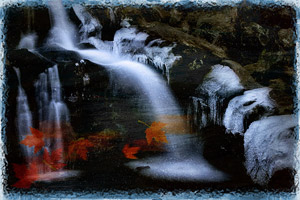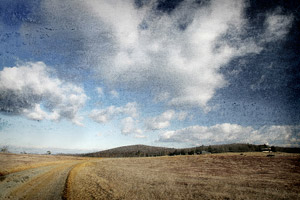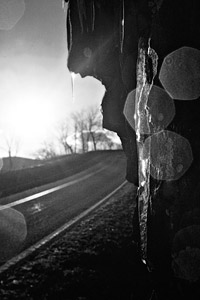Deep Within
I was planning to write this article for quite a while. It's not like one of the previous ones, which you can find on my website. Those articles tell you about technicalities and what I call the language of photography – the composition. It always assumed that if people know the language they can speak. Yes, they can, but could they be eloquent and articulate? Not always, though such qualities may come with time and some practice. However this article not even about eloquence, it is about what gives birth to the mastery and what lies deep within each of us – impression.
Emotional Content
 Most articles that somehow related to art (any kind of art) teach us how to express ourselves in various types of media. But here and now I want to talk about what we want to express – our own feelings and thoughts, about that imprint, which the world leaves in our very soul.
Most articles that somehow related to art (any kind of art) teach us how to express ourselves in various types of media. But here and now I want to talk about what we want to express – our own feelings and thoughts, about that imprint, which the world leaves in our very soul.
If you remember what many masters and teachers tell us, you will definitely remember some words about how to look for certain things, to notice small details and to observe the world. All those teachings actually say that we have to improve our impression of this world. It could be our awareness of fleeting moments in life of a city, mood change of a tropical forest or those expressions on faces of people near us. The world is speaking to us and we have to learn to listen. And only when we can hear and truly understand and feel what it is said to us, we can try to express it.
You probably can easily tell what photograph was one of your greatest achievements. The photograph that moved the viewer and was wowed by many. Such photographs may not always be of a perfect composition, and the technical quality could be mediocre or even poor. Though this photograph has a very strong emotional content. And most probably it was created during those moments when you were most impressed by that event or subject. It means that the photograph simply is a snapshot of your feelings. Yes, it is a snapshot, but this snapshot reveals your feelings. And the stronger the feelings, the greater the impact of the photograph.
I have many examples in my life, when I was bored or simply numb in my feelings about the subject. In such situations even the thorough approach to composition and technical qualities didn't help create a great image. I would even say that such images were boring and numb as well. And how many times, when you are swept by a surge of excitement, when there is no time to even think and you just point and shoot, such images express the whole range of emotions and create great photographs.
That curiosity, excitement, compassion and even pain create great photographs, which we often see in magazines and at photo galleries. The artist simply was able to tell what he felt at that particular moment about the subject or the event. The language helps him to express, but the impression left in his soul is what actually reaches our souls and transforms us.
~ Top ~Life of a Photograph
 Where the photograph is born? And where its life ends? I would say that the photograph is born when we experience things and there is a thought to capture those moments, so we can relive them and/or share with others. The photograph not necessarily should be captured on a sensor or film. We have our own photographs in our mind, sometimes even short movies, which we tell our friends and family members.
Where the photograph is born? And where its life ends? I would say that the photograph is born when we experience things and there is a thought to capture those moments, so we can relive them and/or share with others. The photograph not necessarily should be captured on a sensor or film. We have our own photographs in our mind, sometimes even short movies, which we tell our friends and family members.
And only then we pick up a camera and point in the right direction. At that moment we are deciding how better to express what we have in our mind, what we see in our imagination. Most of the time, this process is very fast and we don't realize it. Only with practice we learn the language of photography and give more thought to the way we express our feelings and see those moments of our life.
After we “almost decided” what we want to include in the photograph, we press the shutter and the camera records the light, the scene, and sometimes the mood. Many people at this point consider their job as a photographer to be completed. But if you read photography magazines and books, you know that there are even special professions such as printers. I am talking about people who transfer the captured in a camera image to the surface of the photographic paper. And it's not a simple process, among their responsibilities you find the post-processing and I would call extracting/increasing the impact, which the photographer saw or experienced while pressing the shutter.
Then if the photograph is truly worth something in the eyes of the viewers there are steps that are taken by photographers or other people in order to present the photographs to the viewers. The photographs could end up in a family album or in a gallery, where people buy them for their collections.
Time passes, the photographs loose their colors and beautiful appearance, but they still revoke those memories and remind as about events or people long gone. And those memories sometimes so strong, that people invest money and effort to restore those photographs or to just keep them intact.
So, why have I ranted about all this stuff? Just because all this effort and time we devote to the photographs is caused by those impressions we captured in our souls. And if those impressions are weak and bleak the images we produce will be not much better even we do all that post-processing. That's why the next section is about being impressed.
~ Top ~To Be Impressed
 I hope by now I was able to convey you the importance of being impressed. We may find proof to such statements in biographies of masters of various arts. Those great guys were deeply involved and devoted to their subjects. It means that they removed all barriers in their minds and souls between them and their subjects. They felt what their subjects felt and expressed those feelings on the media.
I hope by now I was able to convey you the importance of being impressed. We may find proof to such statements in biographies of masters of various arts. Those great guys were deeply involved and devoted to their subjects. It means that they removed all barriers in their minds and souls between them and their subjects. They felt what their subjects felt and expressed those feelings on the media.
Well, those deep feelings are born first when we are impressed by something or someone. When we allow ourselves to feel deep compassion and events of our lives carry us away. My next words may sound like of a shrink, but in our lives we suppress so much good feelings that it's hard to feel them anymore. In my own example, it took me a while to feel the joy and happiness when I am wandering in a wet forest right after the rain, or when it is actually raining. Yes, the weather conditions are far from comfortable, but when you open yourself to the world outside the comfort starts from your soul and then goes through your body. And in such moments almost everything you see is such a wonder, so it doesn't take a great photographer to express all those feelings in a photograph. At those moments you don't think, you just live and experience the happiness. Nothing worries you and nothing pushes you to create a photograph, such as desire to impress you friends or win a contest. You create art because you can and it seems natural.
And when I return from such trips and look at my photographs, I feel all the same feelings (may be less intense), which I experienced and what is more important – people feel them as well. Ansel Adams said: "A great photograph is one that fully expresses what one feels, in the deepest sense, about what is being photographed, and is, thereby, a true manifestation of what one feels about life in its entirety." Isn't it what I am saying here? That the photograph is not only the expression or mastery of expressing yourself, but it's about your feelings about the world, life and its entirety. So, let yourself feel the world and be impressed by it. Remember how you were a kid and felt that every small facet of the world was a wonder. Well, try to see it again and when you feel it you will create much better photographs than at any other time. ![End of the article [end of the text]](http://www.romanzolin.com/img/misc/text_end.png)





